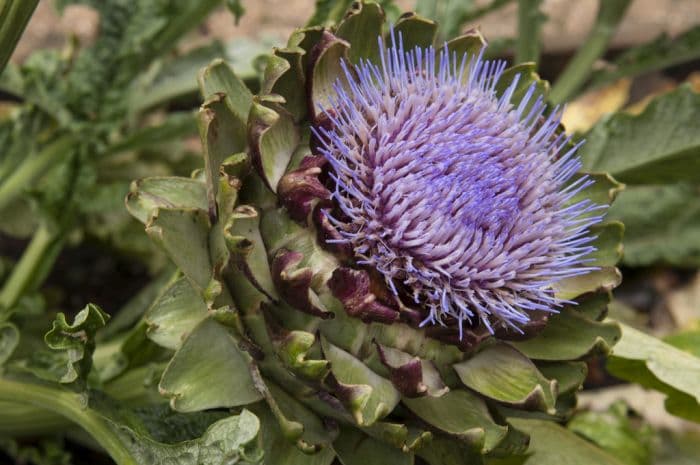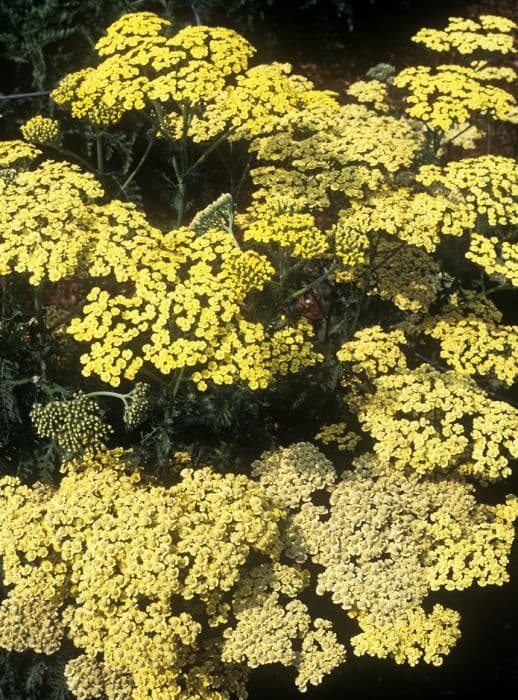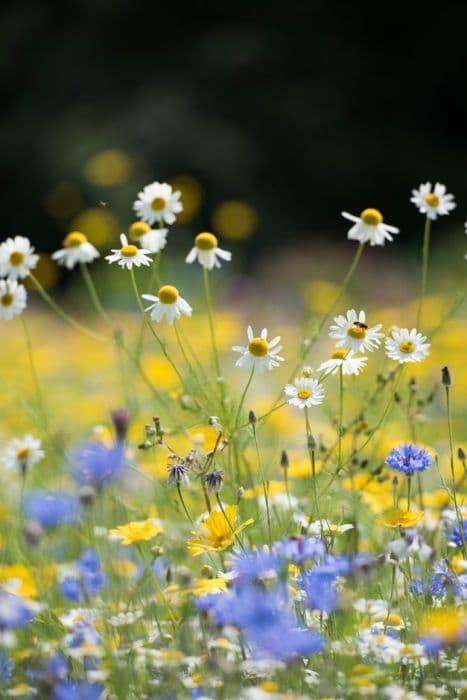Artichoke Cynara cardunculus Scolymus Group

ABOUT
Cynara cardunculus Scolymus Group, commonly known as the Globe Artichoke, is a striking plant with bold features that serve both aesthetic and culinary purposes. The plant is known for its large, showy flower heads with armored-looking scales, which are actually bracts that surround a fuzzy center called the choke, sitting atop a thistle-like bloom. These flower heads have a unique appearance, starting off as a tight, globe-shaped bud before blooming into a large and almost spherical shape with a lush, rigid texture. The protective bracts are typically green with a tinge of purple, but they can vary in color depending on the variety. Nestled beneath these impressive flower heads, the Globe Artichoke has broad, deeply lobed leaves that are silvery-green in color, imparting a bold textural element to the plant's overall appearance. These leaves are arching and can be quite large, adding to the plant's robust presence in a garden setting. The stems of the plant are sturdy and thick, supporting the weight of the dense flower heads. As a perennial, Globe Artichokes can produce multiple flower heads throughout the growing season when properly cared for. The Globe Artichoke delights not only as an ornamental feature but also as a perennial vegetable, with the flower heads being harvested prior to full bloom for their culinary value. The meaty base of the bracts and the heart of the flower head are considered delicacies and can be cooked in a variety of ways, celebrated for their rich, nutty flavor. Overall, the Globe Artichoke is an impressive plant that catches the eye with its distinctive form and texture while providing a tasty treat for those who grow them.
About this plant
 Names
NamesFamily
Asteraceae.
Synonyms
Globe Artichoke, French Artichoke, Green Artichoke, Artichoke.
Common names
Cynara scolymus, Cynara cardunculus var. scolymus.
 Toxicity
ToxicityTo humans
The Cynara cardunculus Scolymus Group is commonly known as the Globe Artichoke, which is not considered toxic to humans. In fact, Globe Artichokes are widely consumed as a vegetable and are known for their health benefits, including being rich in fiber, vitamins, and antioxidants. There are no commonly reported toxicity symptoms associated with the ingestion of Globe Artichokes by humans when prepared and consumed properly. However, it's important to note that some individuals may have allergies to Artichokes, which could result in symptoms such as itching, hives, or gastrointestinal upset.
To pets
The Globe Artichoke (Cynara cardunculus Scolymus Group) is not known to be toxic to pets. It is generally considered safe for animals such as dogs and cats if consumed in small amounts. However, it is not a typical food for pets, and it might cause mild gastrointestinal upset due to its fiber content or if the pet is not used to eating this type of vegetable. If a pet consumes Globe Artichokes and exhibits symptoms like vomiting or diarrhea, it is likely due to the novelty of the food rather than toxicity. Owners should be cautious and introduce any new foods, including Globe Artichokes, into their pets' diets gradually and in moderation.
 Characteristics
CharacteristicsLife cycle
Perennials
Foliage type
Deciduous
Color of leaves
Gray-green
Flower color
Purple
Height
4-6 feet (1.2-1.8 meters)
Spread
3-4 feet (0.9-1.2 meters)
Plant type
Herb
Hardiness zones
7-9
Native area
Mediterranean
Benefits
 General Benefits
General Benefits- Nutritional Value - The plant, commonly known as artichoke, is rich in dietary fiber, vitamins (such as vitamin C and K), minerals (including magnesium, potassium, and iron), and antioxidants.
- Culinary Uses - Artichokes are widely used in cooking, both for their unique flavor and texture, complementing a variety of dishes from appetizers to main courses.
- Gardening and Landscaping - The artichoke plant is appreciated for its large, silvery-green foliage and striking purple flowers, making it a popular choice for ornamental gardens and landscaping.
- Soil Improvement - Artichokes can be used in crop rotation and as a cover crop, helping to improve soil structure and health due to their deep roots and substantial biomass.
- Supports Biodiversity - When allowed to flower, artichoke plants attract a variety of pollinators, including bees and butterflies, supporting local ecosystems.
- Low Maintenance - As a perennial, once established, artichokes require relatively little maintenance, making them a practical addition to many gardens.
- Harvest Flexibility - Artichokes can be harvested at different stages of maturity, offering flexibility in their culinary use and allowing for an extended harvest period.
 Medical Properties
Medical Properties- Cholesterol Reduction: Contains compounds that may help lower blood cholesterol levels.
- Liver Function Support: Used traditionally to improve liver health and function.
- Digestive Health: Contains cynarin, thought to stimulate bile production and aid in digestion.
- Antioxidant Properties: Provides antioxidants that combat oxidative stress and may protect against certain diseases.
- Anti-Inflammatory Effects: Some constituents may have anti-inflammatory properties that could help reduce inflammation.
- Glycemic Control: May have effects on reducing blood sugar levels, beneficial for diabetic individuals.
- Diuretic Activity: Used traditionally as a natural diuretic to help reduce fluid retention.
 Air-purifying Qualities
Air-purifying QualitiesThis plant is not specifically known for air purifying qualities.
 Other Uses
Other Uses- The fibrous leaves of the artichoke can be used to curdle milk in cheese making, as a vegetarian alternative to rennet.
- In some regions, artichoke flowers are dried and used in floral arrangements and decorative displays for their unique appearance.
- The long, sturdy stems of the artichoke plant can be cut and used in basket weaving or other traditional fiber arts.
- Artichoke leaves have been used historically as a source of vegetable-based fabric dye, giving a greenish color to textiles.
- Petals from the artichoke can serve as a natural source of feed for some livestock, especially when other food sources are scarce.
- Crafting enthusiasts use dried artichoke bracts to make eco-friendly ornaments and jewelry, capitalizing on their interesting texture.
- When dried and hollowed out, larger artichoke heads can serve as biodegradable, rustic containers or candle holders for home decor.
- The robust roots of the artichoke plant can provide soil stabilization and prevent erosion in some agricultural or landscape settings.
- Artichoke plants can be used in companion planting to help reduce the population of aphids in a garden without using pesticides.
- Artichoke heads are utilized in vegan cooking to impart a meat-like texture and flavor in plant-based dishes and mock meats.
Interesting Facts
 Feng Shui
Feng ShuiThe artichoke is not used in Feng Shui practice.
 Zodiac Sign Compitability
Zodiac Sign CompitabilityThe artichoke is not used in astrology practice.
 Plant Symbolism
Plant Symbolism- Persistence: The artichoke is known for its perennial growth and long harvest season, embodying resilience and the ability to thrive over an extended period.
- Prosperity: In some cultures, artichokes are considered a luxury food, symbolizing wealth and abundance.
- Hope: Given its thistle-like appearance with a heart inside, the artichoke represents the idea of hope and the reward that comes from facing life's challenges.
- Unique Beauty: With its intricate and unique blossom structure, the artichoke celebrates inner beauty and the notion that what is inside is often more beautiful than exterior appearances.
 Water
WaterThe artichoke, officially known as Cynara cardunculus Scolymus Group, should be watered deeply once a week, providing about 1 to 1.5 inches of water which equates to about 0.62 to 0.94 gallons for each plant, depending on soil type and weather conditions. Ensure the soil is well-draining and maintain consistent moisture, especially during the growing season. Avoid overhead watering to reduce the risk of disease. It's crucial not to let the soil dry out completely, as this can affect the development of the artichoke heads.
 Light
LightArtichokes require full sun to thrive, meaning they should receive at least 6 to 8 hours of direct sunlight daily. The best spot for an artichoke plant is in a location that offers unfiltered sunlight for the majority of the day. Avoid planting in shaded areas, as insufficient light can impede growth and reduce yield.
 Temperature
TemperatureArtichokes grow best in mild temperatures, thriving in a range of 50 to 75 degrees Fahrenheit. They can tolerate a minimum temperature of around 20 degrees Fahrenheit and a maximum of 80 degrees Fahrenheit. Ideal growing conditions are cool nights and warm days, which help promote optimal growth and bud formation.
 Pruning
PruningPruning artichokes is essential to encourage larger, more abundant buds and maintain plant health. Prune by removing any dead or diseased leaves and stalks. The best time to prune is after the main harvest in summer, when cutting back the plant can promote a second smaller crop in the fall. Prune annually by cutting the plant back to ground level in late fall after the growing season ends.
 Cleaning
CleaningAs needed
 Soil
SoilThe artichoke prefers well-drained soil with a pH range of 6.0 to 7.5. A mix rich in organic matter like compost works best to provide the nutrients the artichokes need for optimal growth.
 Repotting
RepottingArtichokes (Cynara cardunculus Scolymus Group) are typically not repotted as they are perennial plants; rather, they are divided or transplanted if necessary.
 Humidity & Misting
Humidity & MistingArtichokes prefer moderate humidity and do not require special humidity adjustments when grown outdoors.
 Suitable locations
Suitable locationsIndoor
Provide sun via south window and water sparingly.
Outdoor
Plant in full sun, protect from wind, and ensure rich soil.
Hardiness zone
7-11 USDA
 Life cycle
Life cycleThe plant Cynara cardunculus Scolymus Group, commonly known as Globe Artichoke, begins its life as a seed, which germinates when soil temperatures reach between 15-20°C (59-68°F). Upon sprouting, the seedling emerges and develops into a rosette of silver-green leaves, establishing a strong root system. After the first year of vegetative growth, the plant enters a short dormancy in the winter. With the return of warmer weather in spring, the Globe Artichoke produces a thick flowering stem that bears large, edible flower buds; if these buds are not harvested, they bloom into striking purple flowers that are highly attractive to bees and other pollinators. Once the flowering cycle concludes, seeds are formed and dispersed if not harvested. The parent plant may die after seeding, which typically occurs in biennial varieties, or it may survive for several years in perennial varieties, repeating the growth cycle in subsequent seasons.
 Propogation
PropogationPropogation time
Spring to Summer
The Cynara cardunculus Scolymus Group, commonly known as the Globe Artichoke, is most commonly propagated by division, a method where sections of the plant's root system, which contain dormant buds, are separated from the parent plant to create new plants. This process is ideally performed in late winter or early spring before the plant breaks dormancy. To propagate by division, gardeners should carefully lift the parent plant from the ground and use a sharp knife or spade to divide the root mass into sections, ensuring that each section has at least one or two growth buds. The sections are then immediately replanted at the same depth they were growing at previously, spaced about 2 to 3 feet (60 to 90 centimeters) apart to allow room for growth. After planting, watering thoroughly helps to settle the soil around the roots and initiate growth. This method provides an exact clone of the parent plant, ensuring consistency in the characteristics of the newly propagated artichokes.









